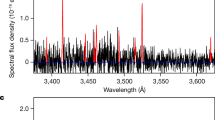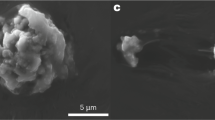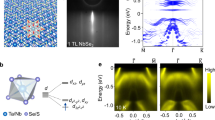Abstract
THE observation of the C2 Swan bands (A3Πg→X3Πu) in emission in the coma of comets was at one time taken as evidence that the ground state of C2 was the X3Πu state since this cometary emission is known to arise by means of a fluorescence process. However, Ballik and Ramsay1 have shown that the ground state of C2 is x1Σ+g and consequently the observation of the Swan bands would be consistent with the following: (1) C2 is formed initially in the triplet system by decomposition (probably photodecomposition) of a hydrocarbon molecule. (2) The 3Πu→1Σ+g transition does not occur to an appreciable extent prior to fluorescence excitation by solar radiation or in the time between successive excitations. The latter implies that C2 experiences an insufficient number of collisions, or possibly no collisions, to effect the forbidden 3Πu→1Σ+g transition. This is not an unreasonable requirement since it is known that the rotational and vibrational distribution of C2 in cometary atmosphere corresponds to a temperature of about 2,500° K and that C2, therefore, must experience few if any collisions between the time of its formation near the nucleus and the time of its excitation farther out in the coma.
This is a preview of subscription content, access via your institution
Access options
Subscribe to this journal
Receive 51 print issues and online access
$199.00 per year
only $3.90 per issue
Buy this article
- Purchase on SpringerLink
- Instant access to full article PDF
Prices may be subject to local taxes which are calculated during checkout
Similar content being viewed by others
References
Ballik, E. A., and Ramsay, D. A., J. Chem. Phys., 31, 1138 (1959).
Stief, L. J., DeCarlo, V. J., and Mataloni, R. J., J. Chem. Phys. (in the press).
Author information
Authors and Affiliations
Rights and permissions
About this article
Cite this article
STIEF, L., DECARLO, V. Origin of the C (A3Πg)→C2(X3Πu) Emission in Comets. Nature 205, 1197 (1965). https://doi.org/10.1038/2051197a0
Published:
Issue date:
DOI: https://doi.org/10.1038/2051197a0
This article is cited by
-
On the photochemical formation of CN, C2, and C3 radicals in cometary comae
The Moon and the Planets (1981)
-
Ion chemistry in the cometary atmosphere
Astrophysics and Space Science (1975)
-
Discussion of the “Forbidden” Intercombination Transition of C2 in Comets
Nature (1968)



